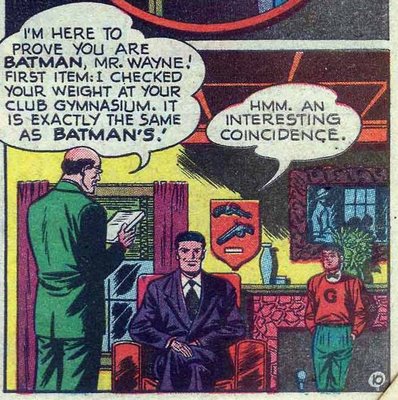Appearances: Action #252-259, Superman #130, Jimmy Olsen #40
Supergirl arrived on Earth in Action Comics #252 (May 1959), apparently following a successful tryout in Superman #123 (August 1958), although the concept of a Supergirl or Superwoman had appeared quite often in the Superman chronicles.
The new Supergirl was Kara Zor-El, Superman's young cousin on his father's side. Her family had been flung into space with the rest of Argo City when Krypton exploded and had survived for years thanks to Zor-El's lining the Kryptonite core of the planetoid with lead to protect the inhabitants. Unfortunately a meteor shower pierced the shields. Before dying (apparently) Zor-El had sent his only daughter, by then a teenager, into space much as his brother had done the same for his only son.
Superman is happy to welcome his only kin to survive Krypton's explosion, but because his identity as Clark Kent must not be divulged, he can't allow her to live with him. So he drops her off at the Midvale Orphanage, where he tells her to keep her super powers secret. She assumes the identity of Linda Lee, a young survivor of a catastrophe that wiped out her town.
At first Supergirl uses her powers in secret to try to help people, sometimes with bad results. For instance, in Action #253 after a farm couple are refused to be allowed to adopt a young farmboy due to poverty, she creates a tourist attraction on the farm which makes them wealthy. Unfortunately, they then decide to move to the city and reason that a farm lad might not suit them, so Supergirl has to go to further extremes to try to make the adoption work.
Supergirl's first major love interest arrives in Action #255 in the person of Dick Wilson (later Malverne). In this story he's mostly played as a secret identity pest a la Lois Lane.
Supergirl's appearance changed a bit over the years. Here's how she looked in the first few issues:

She looked a little different in her appearance in Jimmy Olsen #40.

Rather flat-chested in both, but that would change. The Jimmy Olsen story is played for laughs. Because Superman is busy, Supergirl takes it upon herself to rescue Olsen when he sounds the alarm on his signal watch. She divulges her indentity as Superman's cousin, but temporarily blinded by tear gas, he refuses to believe a Supergirl really exists.
Her appearance in Superman #130 is simply a cameo.
More about →
Supergirl arrived on Earth in Action Comics #252 (May 1959), apparently following a successful tryout in Superman #123 (August 1958), although the concept of a Supergirl or Superwoman had appeared quite often in the Superman chronicles.
The new Supergirl was Kara Zor-El, Superman's young cousin on his father's side. Her family had been flung into space with the rest of Argo City when Krypton exploded and had survived for years thanks to Zor-El's lining the Kryptonite core of the planetoid with lead to protect the inhabitants. Unfortunately a meteor shower pierced the shields. Before dying (apparently) Zor-El had sent his only daughter, by then a teenager, into space much as his brother had done the same for his only son.
Superman is happy to welcome his only kin to survive Krypton's explosion, but because his identity as Clark Kent must not be divulged, he can't allow her to live with him. So he drops her off at the Midvale Orphanage, where he tells her to keep her super powers secret. She assumes the identity of Linda Lee, a young survivor of a catastrophe that wiped out her town.
At first Supergirl uses her powers in secret to try to help people, sometimes with bad results. For instance, in Action #253 after a farm couple are refused to be allowed to adopt a young farmboy due to poverty, she creates a tourist attraction on the farm which makes them wealthy. Unfortunately, they then decide to move to the city and reason that a farm lad might not suit them, so Supergirl has to go to further extremes to try to make the adoption work.
Supergirl's first major love interest arrives in Action #255 in the person of Dick Wilson (later Malverne). In this story he's mostly played as a secret identity pest a la Lois Lane.
Supergirl's appearance changed a bit over the years. Here's how she looked in the first few issues:

She looked a little different in her appearance in Jimmy Olsen #40.

Rather flat-chested in both, but that would change. The Jimmy Olsen story is played for laughs. Because Superman is busy, Supergirl takes it upon herself to rescue Olsen when he sounds the alarm on his signal watch. She divulges her indentity as Superman's cousin, but temporarily blinded by tear gas, he refuses to believe a Supergirl really exists.
Her appearance in Superman #130 is simply a cameo.



























































